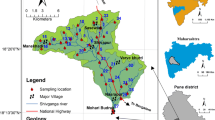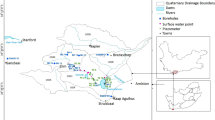Abstract
Regional study on the impact of variations in input rainfall over groundwater quality and its suitability for utilitarian purposes is essential for its extraction and management. Water chemistry from 456 observations wells for 2007–2011 period in hard rock Basaltic terrain of Upper Godavari basin is supported with 8 field samples (in 2014) in this analysis. Based on mean annual rainfall (MAR), four narrow climatic zones are identified in the basin, defined as “humid” (MAR > 1600 mm), “sub-humid” (1600–1000 mm), “semi-arid” (1000–600 mm), and “arid” (MAR < 600 mm). NICB ratio (<±10%), and anionic percentages demarcated the polluted areas from rest “good data”, composing of 1818 samples. Hydrochemical facies are studied using Piper diagram, secondary alkalinity exceeded 50% and not one cation–anion pair exceeded 50%, and silicate–carbonate plot, arid zone nearer to silicate pole indicated the dominance of SiO2 in Ca/Na vs Mg/Na plot. These geochemical variations emphasize a detailed study on role of climatic gradient on groundwater suitability for different purposes, for groundwater extraction, and its management. Suitability of groundwater for drinking based on water quality indices (WQI) indicated 98% of the samples as suitable (WQI < 50%). TDS in humid zone is 150–500 and 500–1000 mg/L in rest of the zones with ∼68% in permissible range, 15% as hard water (TDS > 600 mg/L) and not acceptable for drinking. Suitability of groundwater for irrigation is studied using sodium percentage (Na %), Wilcox diagram, sodium absorption ratio (SAR), US salinity diagram, residual sodium carbonate (RSC), permeability index (PI), Kelly’s ratio (KR), ancd magnesium absorption ratio (MgAR). Na % in four zones is < 60% and permissible for irrigation. Very few water samples fall in “doubtful to unsuitable” and “unsuitable” category of Wilcox diagram. Region is observed to have SAR < 6, indicating that water would not cause any problem to the soil and crop. Humid and sub-humid zones belonged to C1S1 and C2S1 categories (low and medium sodium), while semi-arid extended to C3S1 category (salinity hazard zone) in US salinity plot. RSC for all the three zones ranged from 1 to 1.5 meq/L, with 90–95% of the area safe for irrigation. Out of 1818 samples, 1129 belonged to class 2 of PI classification (PI ranging from 25 to 75%) while rest 689 samples had PI >75% (class 1). KR varied from 0.05 to 12.81, with 70–80% of the area having KR < 1. MgAR ratio ranged from 67% to 96%, with sub-humid, humid zones having higher Mg concentrations (increased salinity). Thus, 90% of the samples indicated non-alkaline water with 1% of normal alkalinity. Hence, the current study systematically analyzed the effect of precipitation and geology on groundwater quality and on its usability for various purposes. This stepwise procedure categorized the regions, and the same can be adopted for any regional hydrogeochemical studies.








Similar content being viewed by others
References
Ahamed AJ, Loganathan K, Ananthakrishnan S (2013) A comparative evaluation of groundwater suitability for drinking and irrigation purposes in Pugalur area, Karur district, Tamilnadu, India. Appl Sci Res 5:213–223
Al-Mashagbah A, Al-Adamat R, Salameh E (2012) The use of kriging techniques with in GIS environment to investigate groundwater quality in the Amman-Zarqa Basin/Jordan. Res J Environ Earth Sci 4(2):177–185
Anbazhagan S, Nair AM (2004) Geographic information system and groundwater quality mapping in Panvel basin, Maharashtra, India. Environ Geol 45(2):753–761
APHA-WWA-WPCF (1998) Standard methods for the examination of water and wastewater, 20th edn. American Public Health Association (APHA), Baltimore
Babar SII (2012) Influence of geological and geomorphological characteristics on groundwater occurrence in Deccan basalts hard rock area of Tawarja river sub-basin Latur, Maharashtra, India. Res J Environ Earth Sci 4(4):440–447
Banerjee T, Srivastava RK (2010) Estimation of the current status of floral biodiversity at surroundings of integrated industrial estate—Pantnagar, India. Int J Environ Res 4:41–48
BIS (2003) Drinking water—specification. Bureau of Indian Standards, New Delhi IS:10500
Broers HP, Grift BVD (2004) Regional monitoring of temporal changes in groundwater quality. J Hydrol 296(1–4):192–220
Brown KB, McIntosh JC, Rademacher LK, Lohse KA (2011) Impacts of agricultural irrigation recharge on groundwater quality in a basalt aquifer system (Washington, USA): a multi-tracer approach. Hydrogeol J 19(5):1039–1051
Chen L, Feng Q (2013) Geostatistical analysis of temporal and spatial variations in groundwater levels and quality in the Minqin oasis, Northwest China. Environ Earth Sci 70(3):1367–1378
Debels P, Figueroa R, Urrutia R, Barra R, Niell X (2005) Evaluation of water quality in the Chillian river (central Chile) using physicochemical parameters and a modified water quality index. Environ Monit Assess 110:301–322
Doneen LD (1964) Notes on water quality in agriculture. Published as water sciences and engineering paper—4001. Department of Water Sciences and Engineering, University of California
Eaton FM (1950) Significance of carbonate in irrigation waters. Soil Sci 67(3):128–133
Ewusi A, Obiri-yeboah S, Voigt HJ, Asabere SB, Bempah CK (2013) Groundwater quality assessment for drinking and irrigation purposes in Obuasi Municipality of Ghana, a preliminary study. Res J Environ Earth Sci 5(1):6–17
Fantong WY, Satake H, Ayonghe SN, Aka FT, Asai K (2009) Hydrogeochemical controls and usability of groundwater in the semi-arid Mayo Tsanaga river basin: far north province, Cameroon. Environ Geol 58(6):1281–1293
Fulazzaky MA (2009) Water quality evaluation system to asses Brantas river water. Water Resour Manag 23:3019–3033
Gemitzi A (2012) Evaluating the anthropogenic impacts on groundwaters; a methodology based on the determination of natural background levels and threshold values. Environ Earth Sci 67(8):2223–2237
Herojeet R, Rishi MS, Lata R, Sharma R (2015) Application of environmetrics statistical model and water quality index for groundwater quality characterization of alluvial aquifer of Nalagarh valley, Himachal Pradesh, India. Sustain Water Resour Management 1(3)
Huizar-Alvarez R (1997) Hydrochemistry of the aquifers in the Rio Las Avenidas Basin, Pachuca, Hidalgo, Mexico. Water Air Soil Pollut 96(1–4):185–201
Joshi DM, Kumar A, Agarwal N (2009) Assessment of the irrigation water quality of River Ganga in Haridwar District, India. J Chem 2(2):285–292
Kamra SK, Lal K, Singh OP, Boonstra J (2002) Effect of pumping on temporal changes in groundwater quality. Agric Water Manag 56(2):169–178
Karmegam U, Chidambram S, Sasidhar P, Manivannan R (2010) Geochemical characterization of groundwater’s of shallow coastal aquifer in and around Kalpakkam, South India. Res J Environ Earth Sci 2(4):170–177
Kelly (1951) Alkali soils—their information properties and reclamation. Reinhold Publishing Corporation, New York
Khan I, Javed A, Khurshid S (2013) Physico-chemical analysis of surface and groundwater around Singrauli Coal Field, District Singrauli, Madhya Pradesh, India. Environ Earth Sci 68(7):1849–1861
Kumar M, Ramanathan AL, Rao MS (2006) Identification and evaluation of hydrogeochemical processes in the groundwater movement of Delhi, India. Environ Geol 50(7):1025–1039
Latha PS, Rao KN (2012) An integrated approach to assess the quality of groundwater in a coastal aquifer of Andhra Pradesh, India. Environ Earth Sci 66(8):2143–2169
Marghade D, Malpe DB, Zade AB (2011) Geochemical characterization of groundwater from northeastern part of Nagpur urban, Central India. Environ Earth Sci 62(7):1419–1430
Naik PK, Awasthi AK, Anand AVSS, Behera PN (2009) Hydrogeochemistry of Koyana River basin, India. Environ Earth Sci 59(3):613–629
Obiefuna GI, Sheriff A (2011) Assessment of shallow groundwater quality of Pindiga Gombe Area, Yola area, NE Nigeria for irrigation and domestic purposes. Res J Environ Earth Sci 3(2):131–141
Oladeji OS, Adewoye AO, Adegbola AA (2012) Suitability assessment of groundwater resources for irrigation around Otte village, Kwara State, Nigeria. Int J Appl Sci Eng Res 1(3):437–445
Pacheco F, Van der Weijden CH (1996) Contributions of water–rock interactions to the composition of groundwaters in areas with a sizeable anthropogenic input: a case study of the water of the Fundao area, central Portugal. Water Resour Res 32(12):3553–3570
Pavelic P, Patankar U, Acharya S, Jella K, Gumma MK (2012) Role of groundwater in buffering irrigation production against climate variability at the basin scale in South-West India. Agric Water Managnt 103(1):78–87
Piper AM (1944) A graphic procedure in the geochemical interpretation of water analysis. Am Geophysical Union Transcr 25:914–923
Raghunath HM (1987) Groundwater. New Age International (P) Ltd., New Delhi
Ramkumar T, Venkatramanan S, Anitha Mary I, Tamilselvi M, Ramesh G (2010) Hydrogeochemical quality of groundwater in Vedaranyam Town, Tamil Nadu, India. Res J Environ Earth Sci 2(1):44–48
Romanelli A, Lima ML, Londono OMQ, Martinez DE, Massone HE (2012) A GIS based assessment of groundwater suitability for irrigation purposes in flat areas of the wet Pampa plain, Argentina. Environ Managnt 50:490–503
Rosemond SD, Duro CD, Dube M (2009) Comparative analysis of regional water quality in Canada using water quality index. Environ Monitoring Assess 156:223–240
Saleh A, Al-Ruwih F, Shehata M (1999) Hydrogeochemical process operating within the main aquifers of Kuwait. J Arid Environ 42:195–209
Singh AK, Mondal GC, Kumar S, Singh TB, Tewary BK, Singh A (2008) Major ion chemistry, weathering processes and water quality assessment in upper catchment of Damodar river basin, India. Environ Geol 54(4):745–758
Sonkamble S, Sahya S, Mondal NC, Harikumar P (2012) Appraisal and evolution of hydrochemical processes from proximity basalt and granite areas of Deccan Volcanic Province (DVP) in India. J Hydrol 438–439:181–193
Soumya BS, Sekhar M, Riotte J, Banerjee A, Braun J (2013) Characterization of groundwater chemistry under the influence of lithologic and anthropogenic factors along a climatic gradient in Upper Cauvery basin, South India. Environ Earth Sci 69(7):2311–2335
Tiwari TN, Mishra M (1985) A preliminary assignment of water quality index of major Indian rivers. Indian J Environ Protect 5:276–279
Vijith H, Satheesh R (2007) Geographical information system based assessment of spatiotemporal characteristics of groundwater quality of upland sub-watersheds of Meenachil river, parts of Western Ghats, Kottayam district Kerala, India. Environ Geol 53(1):1–9
Wilcox LV (1948) The quality of water for irrigation use. US Department of Agricultural Technology Bulletin, Vol. 40:962, Washington DC
Zhou J, Li X (2005) GeoPlot: an excel VBA program for geochemical data plotting. Comp Geosci 32(4):554–560
Acknowledgements
Our special thanks to Groundwater Surveys and Development Agency (GSDA), Pune, for providing us with the necessary data for this research work. This organization is part of the Water Resource Department, Government of Maharashtra, India, and but for their data, this research and analysis would have been impossible. We are also thankful to the Indian Meteorological Department (IMD, Pune) for providing rainfall information for the three districts of our concern. We gratefully acknowledge the support and encouragement received from College of Engineering Pune (COEP) to complete this work. We are also thankful to the editor and reviewers for giving suggestions which have markedly improved the manuscript.
Author information
Authors and Affiliations
Corresponding author
Rights and permissions
About this article
Cite this article
B, S.S., Kamble, R.B. Precipitation controlled spatial variations in groundwater quality indices-suitability for drinking and irrigation purposes in the basalts of South India. Arab J Geosci 10, 171 (2017). https://doi.org/10.1007/s12517-017-2887-2
Received:
Accepted:
Published:
DOI: https://doi.org/10.1007/s12517-017-2887-2




